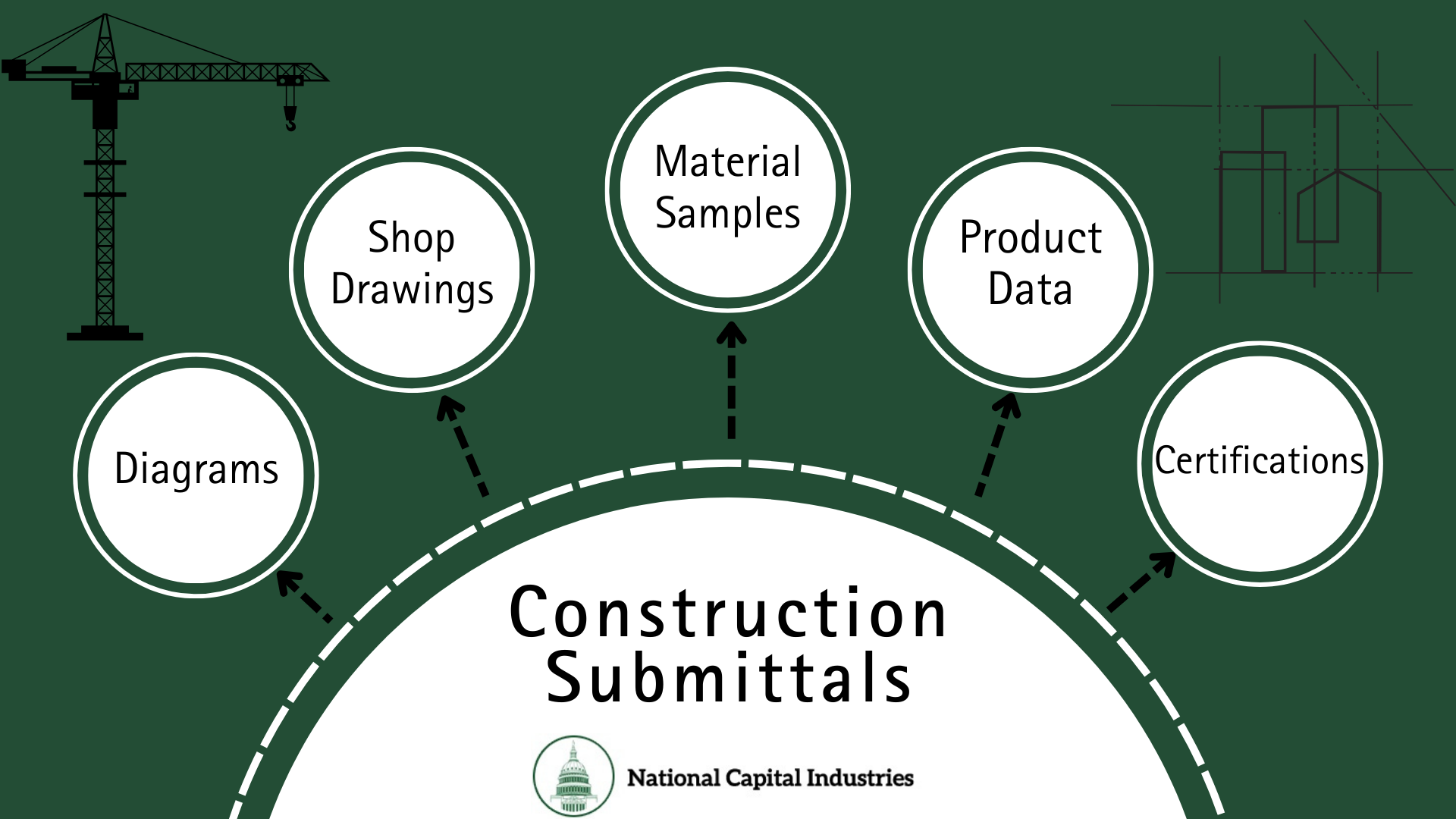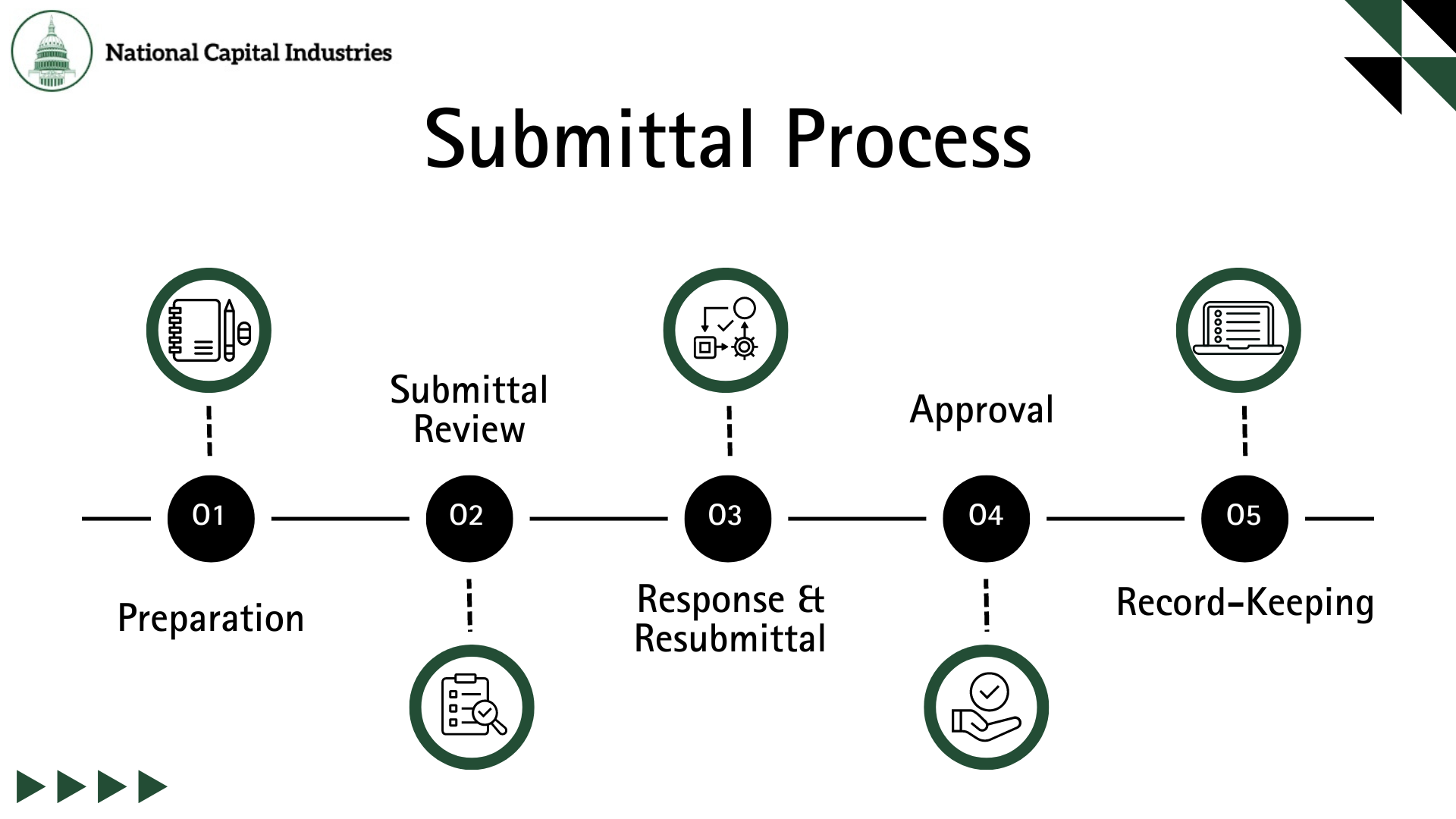
“In construction, a submittal refers to the detailed plans, documents, and data a contractor must present for evaluation and approval during the pre-construction phase.”
When it comes to building safe, dependable structures, a few steps are as vital to the success of a construction project as the submittal process. This important paperwork covers a wide range of elements, including diagrams, shop drawings, material samples, and product data, each meticulously prepared to align with the project’s contract requirements.

Submittals are an integral part of construction processes because they ensure all the involved parties are aligned and that every product or process conforms to the contract documents. From the tiniest screw to the largest piece of construction equipment, every item ultimately used on a construction project must go through this rigorous review process.
The submittal process in construction is a key pathway for exchanging information between the project stakeholders – from the contractor to the design team, and from the project manager to the construction manager. This exchange ensures everyone involved has all the necessary information to make informed decisions, effectively facilitating the smooth execution of the construction project.
A vital element in this process is the ‘certification,’ which verifies that the proposed materials, practices, and items comply with strict industry standards. While it might seem like just another document to submit, obtaining the right certifications can often be the make-or-break factor in whether a project successfully meets contract requirements and ultimately, whether it gets the green light to progress to the next phase.
Different types of certifications may be necessary depending on the nature of the construction project. They might include:
These certifications are not just a ‘nice to have’; they are obligatory components of the submittal process that validate that the proposed materials and techniques fit their intended purpose, ensuring overall project safety.
Certifications grant materials, practices, and techniques access to a construction project. Without these essential documents affirming product compliance, project stakeholders might find themselves dealing with rejected submittals, delaying the project’s timelines and potentially inflating costs.
Gaining a comprehensive understanding of the next stages can provide project managers, contractors, and all team members involved with a clear roadmap to navigate this essential part of construction projects successfully.

The general contractor is typically responsible for the initial submittal, but it must be a collaborative effort involving other construction professionals. It includes acquiring product data, shop drawings, and physical samples of materials to be used, which are then compiled into a submittal package.
Once the package has been prepared, it goes to the design team for review. Detailed plans are checked against contract requirements, and material samples are assessed for quality and suitability. Any discrepancies between construction drawings, detailed plans, and the actual state of the site are brought to light at this stage, and additional information may be required.
If any portion of the submittal is deemed unsatisfactory, the package is returned to the contractor for corrections. The contractor must then revise the incorrect materials, incorporate the necessary changes, and resubmit the package for another round of reviews.
After all the corrections have been made, and all components of the submittal meet the contract requirements, the design team gives their nod of approval. This signal implies that the proposed materials, techniques, and methods are following the project’s goals and can be implemented.
Once the approval process is complete, all documents, including approvals, submittal documents, and review notes, should be archived. This step allows for better project management, and accurate audits, assuring compliance with industry standards up until the closeout submittal.
Modern project management software offers substantial help in streamlining this process by serving as a comprehensive repository for all relevant information and ensuring all project stakeholders are kept in the loop.

Even with meticulous planning and communication, the submittal process can present several challenges that may stunt the progress of a construction project. However, being aware of these issues and knowing how to address them efficiently can ensure the construction process remains on track.
Overcoming these challenges requires clear communication, thorough documentation, and strict adherence to the submittal schedule. It is equally important to make sure all team members are well-versed in their roles in the process and understand the importance of each step.
There is no denying that the submittal process can be overwhelming. However, with the right expertise and reliable partners like National Capital Industries, you can navigate through these challenges with ease.

At National Capital Industries, we understand the intricacies of the construction submittal process. With over 60 years of experience in the construction industry, we’re adept at helping teams make their way through the complexities of submittal items. From selecting the correct materials to ensuring all certifications are current and compliant, NatCap’s support can be the catalyst for a successful project.
We assist contractors with comprehensive product data, thereby ensuring that all required submittal documents are readily available and sufficiently detailed. Whether it’s technical data or product specifications, our experienced team of professionals can provide you with the necessary information in an easily accessible and understandable manner.
At NatCap, we emphasize keeping all certifications up-to-date, thereby aligning with the latest industry standards. This proactive approach not only aids in the approval process but also builds trust and confidence with the project stakeholders. We are easily able to look up local DOT or other agencies to ensure your product aligns with the requirements. If you don’t know where to start in this process, we have you completely covered.
In addition to these, we offer expert advice on how our products can meet project-specific requirements. Guiding you through potential compatibility issues, installation procedures, or even assisting with customized solutions, we aim to ensure that every step of your construction process is as seamless as possible.
Our responsive customer service also plays a crucial role in streamlining the submittal process. We understand that quick responses to your questions about product specifications and submittal documents can significantly accelerate the approval process, ensuring that your project stays on track. Even years down the line, if you need a certification for a NatCap product, simply contact us and we’ll get you what you need.
With National Capital Industries as your partner, you gain much more than just a vendor. We position ourselves as your guide, helping to navigate you through the demanding landscape of the construction submittal process. Our customer-centric approach empowers us to build a mutually rewarding partnership — one where we’re always ready to go the extra mile to support you.
By proactively assisting in the efficient handling of the construction submittal process, NatCap not only ensures smoother progression of your construction projects but also strengthens its reputation as a reliable partner in the construction industry. Partnering with us means getting on your way to a flawlessly executed construction project.
National Capital Industries — Making the complex simple, one construction project at a time.
ASTM International – Standards Worldwide, www.astm.org/. Accessed 18 Apr. 2024.
“International Organization for Standardization.” ISO, 31 Jan. 2024, www.iso.org/home.html.
“Home: NCHRP.” Transportation Research Board, www.trb.org/NCHRP/NCHRP.aspx. Accessed 6 Apr. 2024.